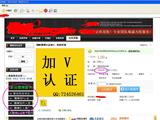Sina Weibo Profit Model: Grafting E-commerce, Re-entering IM Field
Weibo News Network excerpted from Hexun.com related articles:
Sina Weibo launches instant messaging air client to challenge Tencent's core IM business.
Sina CEO Charles Chao: To grow Weibo, Sina can revolutionize itself.
Sina invests $66 million in Mecox Lane for 19% equity, leveraging Weibo to enter e-commerce.
Sina's financial report shows: Sina Weibo has more than 100 million registered users. Areas that Sina was not previously good at, such as search, e-commerce, and gaming, can all evolve into new business models through integration with Weibo. Recently, Sina CEO Charles Chao announced the expansion plan of Sina Weibo, which includes at least doubling the team size and significantly increasing marketing expenses.
Weibo is undoubtedly the brightest star of 2010. As a leader, Sina has benefited greatly, gaining a good reputation and its stock price has doubled. Having become a second-tier giant, Sina hopes to turn things around through this. Therefore, finding an appropriate profit model for Weibo has been put on the agenda.
It is not difficult to understand why Sina Weibo has been so active recently: open platform strategy, cooperation with MSN, investment in Mecox Lane, launching of IM tools, etc.
Will Weibo's profitability, the increasing complexity of functions on Weibo, and the decreasing amount of content to view dilute its value as a new medium? Renowned independent IT commentator Hongbo believes that Sina places too much hope on Weibo, which may be beyond what a single product like Weibo can bear.
Sina's ambition in e-commerce
On March 2nd, Mecox Lane announced that Sina and Kappa China's subsidiary will purchase 117.5 million ordinary shares from two major shareholders of Mecox Lane, Maxpro Holdings Limited and EverKeen Holdings Limited under Sequoia Capital. Among them, Sina will purchase 76.987 million ordinary shares, accounting for about 19% of Mecox Lane's total issued shares.
Mecox Lane Director and CEO Gu Beichun told Times Weekly that Sina is China's largest portal site, with a newly developed interactive community Weibo, possessing a large amount of advertising and user resources, making it very attractive to any e-commerce company.
Sina indeed has the ambition to enter the e-commerce sector. At the beginning of January this year, Sina quietly launched a payment tool called Xin Futiong. Moreover, when registering for Sina Weibo and filling out personal information forms, there is an option for delivery address, which makes people speculate about the combination of Weibo and e-commerce. Charles Chao said that within the next ten years, e-commerce will become the growth driver of China's Internet, presenting a huge opportunity for Sina.
In the last six quarters, the development of e-commerce, especially the B2C market, has indirectly increased Sina's advertising revenue. Considering the massive user base and traffic foundation, Sina hopes to explore direct participation in e-commerce. Said Charles Chao.
Mecox Lane is just our first step in this market, allowing us to gain B2C experience. In the future, we will have more actions in the e-commerce field. Charles Chao believes that starting with Mecox Lane is appropriate, as the company is transitioning from a mail-order catalog model to e-commerce, already having a brand and scale foundation. Sina's vast user base and marketing capabilities will help Mecox Lane fully transform into an e-commerce company.
Senior internet expert Yu Ming believes that Sina's entry into e-commerce can maximize the value of its own users. The failure of Baidu Youa has proven that low-stickiness users are difficult to convert into e-commerce users, but Weibo has higher stickiness and better word-of-mouth dissemination effects, offering great imaginative space when combined with e-commerce.
Founder of iMeigu Fang Sanwen stated that this round of investment can vaguely reveal Sina's attempt to introduce Weibo e-commerce's profit model through Mecox Lane. For most micro-merchants, opening a store has a high threshold, while e-commerce only requires a customer service account with geographical positioning and micro-payment functions. This could be the landscape of e-commerce in the mobile internet era. And Weibo is the product that can most easily possess these functions.
Through cooperation with Sina, Mecox Lane can try Weibo as a new entrance, thus avoiding the cost of purchasing entrances from Baidu and Taobao Mall like other e-commerce companies.
However, Hongbo believes that even if Sina enters the B2C sector, there is no reason to choose Mecox Lane, an e-commerce company mainly based on offline stores, call centers, and mail-order catalogs.
The main reason for investing in Mecox Lane is still the capital operation between Sina and Sequoia Capital. An investment industry insider believes that Sequoia Capital's consistent style is to gradually exit after the invested company goes public. Previously embroiled in lawsuits, Mecox Lane's stock price has fallen below the issue price. Sina and Kappa China taking over allows Sequoia Capital to cash out $1 billion (recovering the initial $80 million investment in Mecox Lane and netting a $20 million profit) without causing significant impact on Mecox Lane's stock price.
Weibo IM targets Tencent
Sina Weibo's ambitions are not limited to e-commerce, but possibly also include IM (instant messaging).
During the 3Q war last year, there were comments on Sina Weibo that the battle between Tencent and 360 in 2010 was just a prelude, and in 2011, Tencent would battle with Sina. Zhou Hongyi joked about this: Perhaps Pony Ma now realizes that what颠覆Tencent is originally Sina Weibo.
Also during the 3Q war, Sina and MSN carried out a strategic cooperation, covering products such as blogs, instant messaging, news content, and wireless services. Additionally, Sina has an IM instant messaging software called UC, but its operational effect has always been poor.
On March 7th, Sina Weibo launched an instant messaging tool called Weibo AIR, supporting operating systems such as Windows, Mac, and Linux. The biggest highlight of the desktop client is its functionality and interface design similar to regular instant chat software.
The Weibo chat function is merely an extension of the private message function. If Li Kaifu does not follow you, you cannot chat with him, making it asymmetric. Hongbo believes that the Weibo chat tool has little to do with IM.
Analysys International believes that the market prospects of Sina's IM function mainly depend on the user experience of smooth communication. Although it is difficult to shake Tencent QQ's dominant position in the domestic IM field, which accounts for seventy percent of the market, relying on a user base of 100 million Weibo users would cause quite a shock to QQ's market share.
Betting on Weibo
Recently, Charles Chao almost only talks about Weibo when interviewed by the media. Entering 2011, we plan to make Weibo the core of Sina's new media growth strategy, increasing investment to further enhance our leading position in the social media field, making Sina the best network platform deeply rooted in social networks and mobile internet. He said.
On March 2nd, Sina released the first complete scorecard of Weibo's development so far: over 100 million users, active user ratio comparable to Twitter, average online time far exceeding Twitter.
Of course, Sina is a listed company, and people are more concerned about how Weibo will generate profits?
Charles Chao said that the focus of Sina Weibo this year is to increase investment and improve product quality. The scale of the Weibo department, currently 600 people, will double this year. Efforts will be made to promote Weibo in second and third-tier cities.
First, increase the number of users and consolidate the leading position. Looking at the development history of the Internet, considering how to make profits from the start often leads to failure. True profitability is generated on the basis of forming a user scale.
However, this does not mean that Sina is not preparing to make Weibo profitable. Charles Chao said, we are still developing various profit-making methods, including advertising systems, real-time search, etc., which will become important profit-making means in the future. We are also building a game platform connected to the Weibo platform, with a promising profit outlook. In the short term, we can conduct cross-selling between the portal site and the Weibo platform.
He revealed that Sina Weibo will launch a new version in the second quarter, and more profit model experiments will be conducted then.
Credit Suisse's research report also stated that six advertising agencies and advertisers have expressed strong interest in cooperating with Sina, hoping to embed soft advertisements and communicate with the masses through Weibo. Sina is selling a bundled marketing promotion package that includes Weibo products.
While trying to make profits, we will avoid affecting user experience and will not place advertisements directly on each user's page, nor disrupt user behavior patterns and experience. Charles Chao answered analysts' questions like this.
Perhaps Sina's full effort in building Weibo is not intended to directly profit from Weibo, but rather to achieve a strategic transformation through Weibo's open platform, transitioning from a Web1.0 news portal to a powerful open user platform with a large number of highly sticky users in Web2.0.
At that point, will profitability still be a problem? But during this process, Charles Chao and Sina will face a lot of pressure. Facebook is like a big river; in the West, you just need to be a big fish in this river. China's big river is Tencent, but Tencent only wants to raise its own fish. Will Sina become the next big river?




